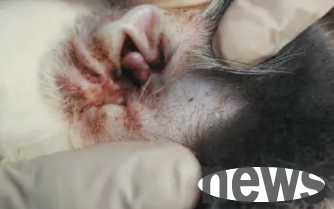Cat ear mites are ectoparasitic diseases caused by cat ear mites (Otodectes cati) parasitize on the skin surface of the cat's external auditory canal. Mites parasitize on the skin surface of the external auditory canal of animals, causing inflam...
Cat ear mites are ectoparasitic diseases caused by cat ear mites (Otodectes cati) parasitize on the skin surface of the cat's external auditory canal. Mites parasitize on the skin surface of the external auditory canal of animals, causing inflammation of the external ear, often secondary to bacterial infection, and lesions can spread to the middle ear, inner ear and even the brain, causing serious systemic symptoms. People with delayed course of the disease or unhealing for a long time often have poor prognosis.

1. What is ear mites
ear mites, also known as ear scabies, are called Otodectes cynotis. They mostly parasitize in the ear canals of cats and dogs, and there are also a few parasitizes in the head, neck and tail. Generally speaking, female insects are larger than male insects and can parasitize in hosts such as cats, dogs, and foxes. The insect body has strong resistance and can survive in a livestock house at 6 to 8℃ for about 2 months, and dies after 6 hours at -25℃.
2. Clinical symptoms, diagnosis
Clinical symptoms:
(1) Mainly manifested as itching, shaking the head and scratching the ears, frequent scratching the ears or shaking the head. Be careful that it is frequent, and it is normal to scratch occasionally.
(2) There are a large amount of dark and brown secretions in the external auditory canal.
(3) Strong itching may lead to self-harm, bleeding and ear hematoma.
(4) A small number of affected cats scratch the periart of the ear with their claws due to itching, resulting in open scabbed skin wounds on the back or base of the ear.
Diagnosis:
Microscopy:
According to clinical symptoms, combined with laboratory examination, ear mites and eggs were found, and it was diagnosed as cat ear mites. Based on the results of bacteriological examinations and routine blood tests, referring to the local pus flow symptoms, it is determined that the concurrent bacterial infection is staphylococcus, and the possibility of Pseudomonas, intestinal bacteria or anaerobic bacteria is not ruled out. The infection site is deep into the middle ear, which is bacterial suppurative otitis media (the cat who has already had typical symptoms of otitis media when visiting the hospital).
3. Treatment principles
Combining clinical actual situation and laboratory examination results, formulate treatment plans. For cats that have already experienced secondary symptoms, systemic medication is the main one, combined with local medication; the first 3 to 5 days of treatment is mainly antibacterial and anti-endotoxic (bacterial toxin) shock drugs, supplemented by antiparasitic drugs and symptomatic treatment; after the condition is stable, antiparasitic drugs are the main one, supplemented by antibacterial drugs.

4. Prevent cats who often go out, use deworming medicine once every 3 months.
(2) When going out, avoid contact with other dogs and cats as much as possible;
(3) If there is a cat or dog at home that has been infected with ear mites, be sure to feed other cats and dogs separately, and do not contact cats and dogs with ear mites.
(4) Regularly clean and disinfect the mats and cages used by dogs and cats.